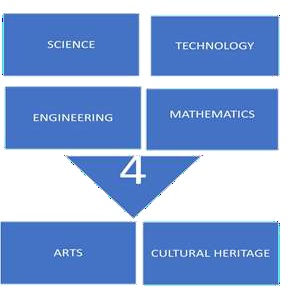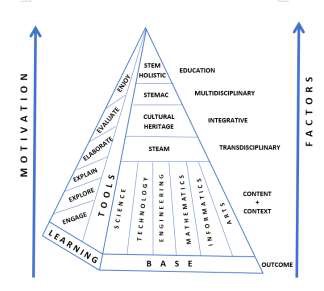STEMAC (Science, Technology, Engineering, Mathematics for Arts & Culture): The emergence of a new pedagogical discipline
Abstract
A new transdisciplinary and interdisciplinary field that emerges in pedagogics is commented. Arts coupled with Science, Technology, Engineering and Mathematics (STEM) is the STEM with Arts (STEAM). It introduces students and educators to an holistic approach in classroom. STEAM removes limitations and replaces them with wonder, critique, inquiry, and innovation.
This editorial commentary introduces to Scientific Culture readers to the current status and potential of this field and initiates a further step to encompass Culture, as well. This is the STEMAC (Science, Technology, Engineering, Mathematics for Arts & Culture), novel, and, surely integrated reapprochement, which reinforces the fragmentary bridges and sort of lack of coherence, between natural sciences and engineering & technology, with, and, for humanities (art / culture).
Keywords: arts, cultures, cyber-archaeometry, archaeometry, cultural heritage, STEM, STEAM, brain, holistic, education.
Introduction
In the current era science with technology, engineering and maths working together with Arts (STEAM) values the benefits of science-technologyengineering-mathematics (STEM) and fulfils the set by merging these principal disciplines. STEAM rises up STEM to the next level: it provides students to network their learning in these critical areas together with arts concepts and practices, design principles, and standards in such a way to provide the whole floor of learning at their disposal (Watson & Watson, 2013).
STEAM is developed to integrate STEM scientific subject categories into various relevant disciplines for education. These constructed programs aim to teach apprentices to think critically and use engineering, technology, natural sciences in virtual designs or creative approaches to real-world problems while building on them mathematics and science base. Thus, STEAM programs add Art to STEM curriculum by depicting on design principles and enheartening and invigorating creative solutions (https://vtnews.vt.edu/articles/2012/07/073112-uged-steampartnership.html; http://www.miscositas.com/steam.html; Yarkman, 2012). A thorough overview on the subject on Computational STEAM Pedagogy is included in the present issue of the Journal (Psycharis, 2018).
The current and new proposed initiative
The STEM, STEAM etc, and more anticipated acronyms enter the educational systems designed by policy makers. In any case, a sine qua non condition to accept and foster by proper implementation expected new disciplines to overcome problems of communication and establishing an ordering procedure is a prerequisite most needed issue; disambiguation through the definition of terminology (or jargon). Much to this end has been met in the digital era, or the cyber era, of coupling computer sciences with archaeology and cultural heritage (Liritzis et al., 2015a, and references therein). The Arts could include: Musical Arts & Sounds, Performing Arts, Language Arts, Visual Arts, Social Arts, Ecological Arts & Architecture. The Culture encompasses the tangible (material culture e.g. cultural heritage, cultural property) and intangible culture (e.g. religion, dance, traditions, singing, mythology, literature et.c) much overlapping with Arts (for difference between culture and civilization see: http://www.newworldencyclopedia.org/entry/Culture). From the Exact Sciences STEM encompasses natural sciences and engineering & technology, with all sub-fields.
To study the past cultures and rejoin arts and cultural heritage with STEM, any holistic approach to understanding cultural change must also include consideration of changes in the environment in which a society exists; this is applied to a temporal pace throughout the time (palaeolithic, prehistoric, historic societies). It recalls Cyber-archaeometry which is the digital IT process of simulation, restructuring and management of archaeometric processes from the field of natural sciences in relation to material culture, investigated variously (dating, prospection, analysis, technology, provenance, archaeoastronomy, etc.), either as optimum recruited image or as targeted research quest (Liritzis et al., 2015b).
Figure 1 STEMAC: motivation, tools, factors
Along the latter view, it emerges the STEMAC (science, technology, engineering, mathematics for Arts & Culture; or STEM4AC); a novel, and, surely integrated rapprochement, which reinforces the fragmentary bridges and sort of lack of coherence, between natural sciences and engineering & technology, with, and, for humanities (art / culture) (Fig.1, 2).
STEMAC aids the transculturation via STEM in a globalized society preserving the cultural roots and interrelated the beginnings and common traits of humanity, diversified from various environmental factors (Liritzis, 2013). The introduction and implementation of educational programmes from STEAM to STEMAC satisfies the long known efficient learning procedures in combining the different left and right brain functions.
Both sides of the brain determine personality, traits, personal abilities: The left controls muscles on right side of body, language, mathematics, logic, speech, analytical process and intellectuality; the right controls the spatial abilities, facial recognition, visual imagery, art and music, emotion and creativity (Nielsen et al., 2013).
Figure 2. STEM for Arts and Culture (STEMAC)
Using software from computer sciences and maths (PHP progammes, online games, Java script programming, and other algorithms and software) one can start working with STEAMAC and on various archaeological, anthropological, artistic subjects, monuments, tangible and intangible cultural heritage issues.
STEM or STEAM alone miss several key components that lead to the feasible holistic approach, that many employers, educators, and parents have voiced as critical for our children to thrive in the present and rapidly approaching future. STEMAC could offer such miss and develop to an educational approach to learning that uses of Science, Technology, Engineering, Mathematics in Arts and Culture as access points for guiding student inquiry, intercultural dialogue, critical thinking, understanding, realization of a common language; that of STEM. The end results are students who take thoughtful risks, engage in experiential learning, persist in problem-solving, embrace collaboration, and work through the creative process, all targeted to an interesting other half; the humanities (Fig.2).
However, STEM and STEAM are usually developed theoretically with some experiencing examples in pre-school or primary school level (http://www.miscositas.com/steam.html). The need to expand in high school and higher establishments syllabuses is a must on a commensurate and relevant way regarding age groups, psychologies involved, and specific case studies examples.
Examples
Using proper tools from STEM applied to Arts & Culture could refer to some interesting topics, here we mention some: a) teaching astronomy from astronomical significant monuments, and artifacts, deciphering and simulating myths related to cultural heritage measurements (Liritzis & Castro, 2013; Castro et al., 2015; Panou & Violetis, 2018), b) developing archaeometry via STEM to STEMAC (the application of natural sciences and technology to solve archaeological problems related to chronology, characterization, provenance, palaeoenvironmental reconstruction, digital simulation, virtual reality etc., for example, Hatzopoulos et al., 2018; Liritzis et al., 2016), c) developing cyber-archaeometry (Liritzis et al., 2015b) to STEMAC developing e.g. a virtual optical microscope examining archaeological artifacts, identification and characterization, as well as, learning outcome of science, mathematics and computer sciences, engineering, and infrastructure (hardware) to higher education students. Similarly, the obsidian hydration dating by simulating the physical phenomenon, instrumentation for measuring diffused water into the obsidian blade, and many more (Liritzis & Laskaris, 2011). This way the learning outcome, evaluation, integration, stimulates the 6 E’s: Engage, Explore, Explain, Elaborate, Evaluate, Enjoy (Fig.2). One must not forget the 6th one as any educational process for learning should inhere the advantage of entertainment and happiness. STEMAC may reinforce naturalistic methodology, which serves as the basis of a synoptic and synthetic philosophy that involves art and science corresponding to classical techne and logos (Liritzis, 2013).
Conclusion
STEM to STEAM for pedagogical purposes increasing awareness and enhancing learning outcome has to be expanded to the new field of STEMAC to include arts and cultures i.e. humanities and integrate in a more efficient way the coupling and interdisciplinarity – transdisciplinarity concerning content and context, between the natural sciences and technology and engineering with arts and cultures especially cultural heritage. The latter has been going on with another name (archaeometry) and it easily can be integrated and form the strong knot of STEMAC.
References
Castro, B, Liritzis, I and Nyquist, A (2015) Oracular Functioning And Architecture of Five Ancient Apollo Temples Through Archaeastronomy: Novel Approach And Interpretation Nexus Network Journal, Architecture & Mathematics, Vol.18, No. 2, 373-395. (DOI:10.1007/s00004-015-0276-2)
Hatzopoulos, J, Stefanakis, D, Georgopoulos, A, Tapinaki, S, Volonakis, P, Liritzis, I (2017) Use of various surveying technologies to 3d digital mapping and modelling of cultural heritage structures for maintenance and restoration purposes: the tholos in DELPHI, GREECE. Mediterranean Archaeology and Archaeometry, Vol. 17 No 3, pp. 311-336.
Liritzis, I, Pavlidis, G, Vosynakis, S, Koutsoudis, A, Volonakis, P, Petrochilos, N, Howland, D.M, Brady Liss & Levy, T.E. (2016) DELPHI4DELPHI: first results of the digital archaeology initiative for ancient Delphi, Greece. ANTIQUITY Gallery (90 354, e4 (2016): 1–6, doi:10.15184/aqy.2016.187
Liritzis, I and Castro, Β (2013) Delphi and Cosmovision: Apollo’s absence at the land of the hyperboreans and the time for consulting the oracle. Journal of Astronomical History and Heritage, 16(2), 184-206.
Liritzis, I, Al-Otaibi, F.M, Volonakis, P and Drivaliari, A (2015 a) Digital technologies and trends in cultural heritage. Mediterranean Archaeology and Archaeometry, Vol. 15, No 3, pp. 313-332 (DOI: 10.5281/zenodo.33832)
Liritzis, I, Volonakis, P, Vosinakis, S, Pavlidis, G (2015 b) Cyber-archaeometry from Cyber-archaeology: New dynamic trends in archaeometric training and research. In Virtual Archaeology (Methods and Benefits), Daria Hokk (ed), Proceedings of the Second International Conference held at the State Hermitage Museum 1–3 June 2015 Saint Petersburg The State Hermitage Publishers, 38-40.
Liritzis, I & Laskaris, N (2011) Fifty years of obsidian hydration dating in archaeology, J. Non Crystalline Solids, Vol.357, 211-219.
Liritzis, I (2013) Twelve thousand years of non-linear cultural evolution: The physics of chaos in Archaeology. SYNESIS: a journal of science, technology, ethics and policy, G19-31.
Nielsen, J.A, Zielinski, B.A, Ferguson, M.A, Lainhart, J.E, Anderson, J.S (2013) An Evaluation of the Left- Brain vs. Right-Brain Hypothesis with Resting State Functional Connectivity Magnetic Resonance Imaging. PLoS ONE (8(8): e71275. https://doi.org/10.1371/journal.pone.0071275).
Panou, E and Violetis, A (2018) Teaching astronomy using Monuments of Cultural Heritage: The Educational Example of “Horologion of Andronikos Kyrrhestes. SCIENTIFIC CULTURE, Vol.4, No.2, 77-83.
Psycharis, S (2018) STEAM in Education: A Literature review on the role of Computational Thinking, Engineering Epistemology and Computational Science. Computational STEAM Pedagogy (CSP). SCIENTIFIC CULTURE, Vol.4, No.2, 51-72.
Watson, A.D., Watson, G. H. (2013). Transitioning STEM to STEAM: Reformation of Engineering Education. Journal for Quality and Participation, Vol 36, No.3, pp. 1-5.
Yakman, G.P (2012) Exploring the Exemplary STEAM Education in the U.S. as a Practical Educational Framework for Korea. Journal of the Korean Association for Research in Science Education, Vol. 32 No. 6, 1072-1086.







